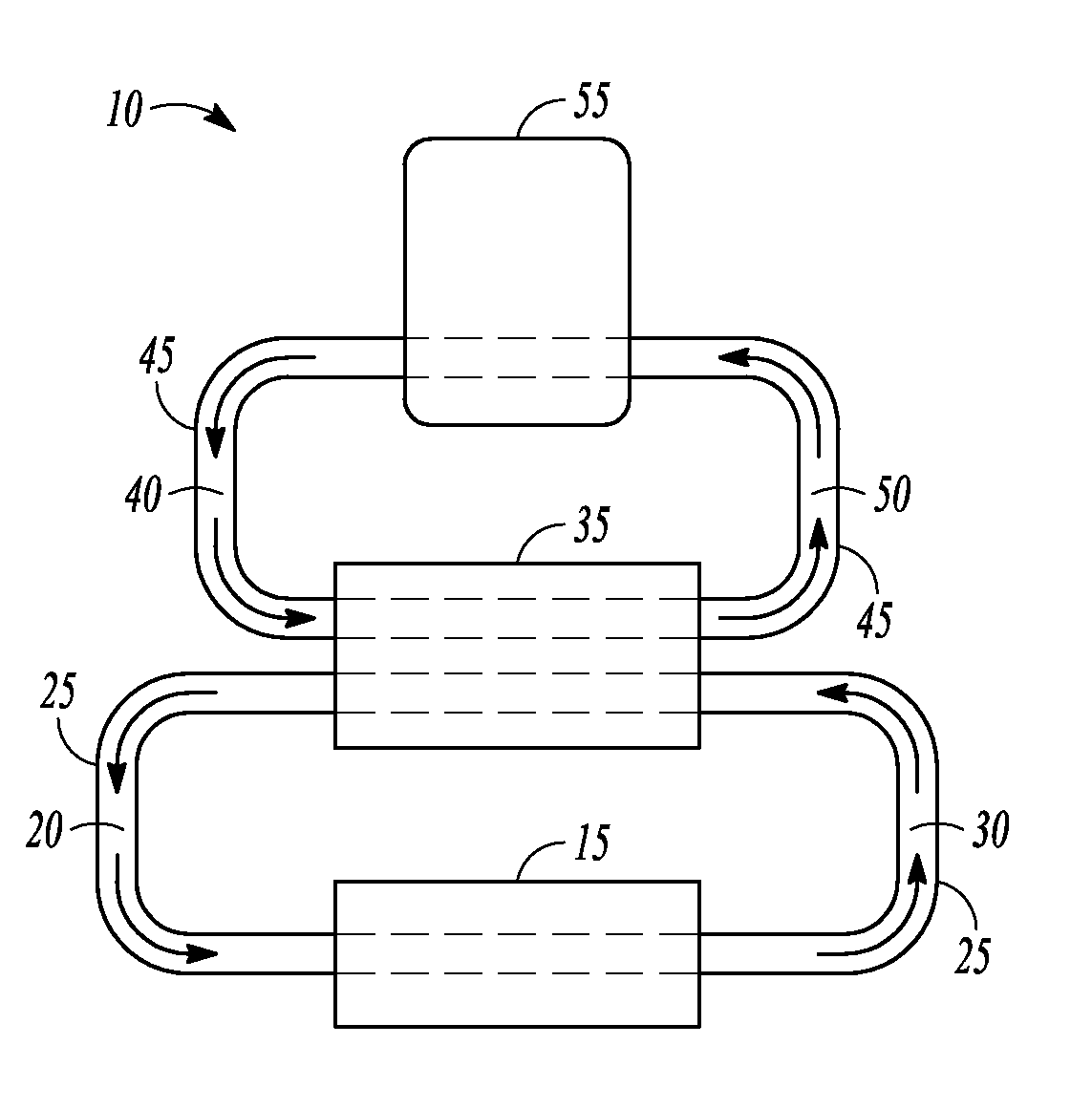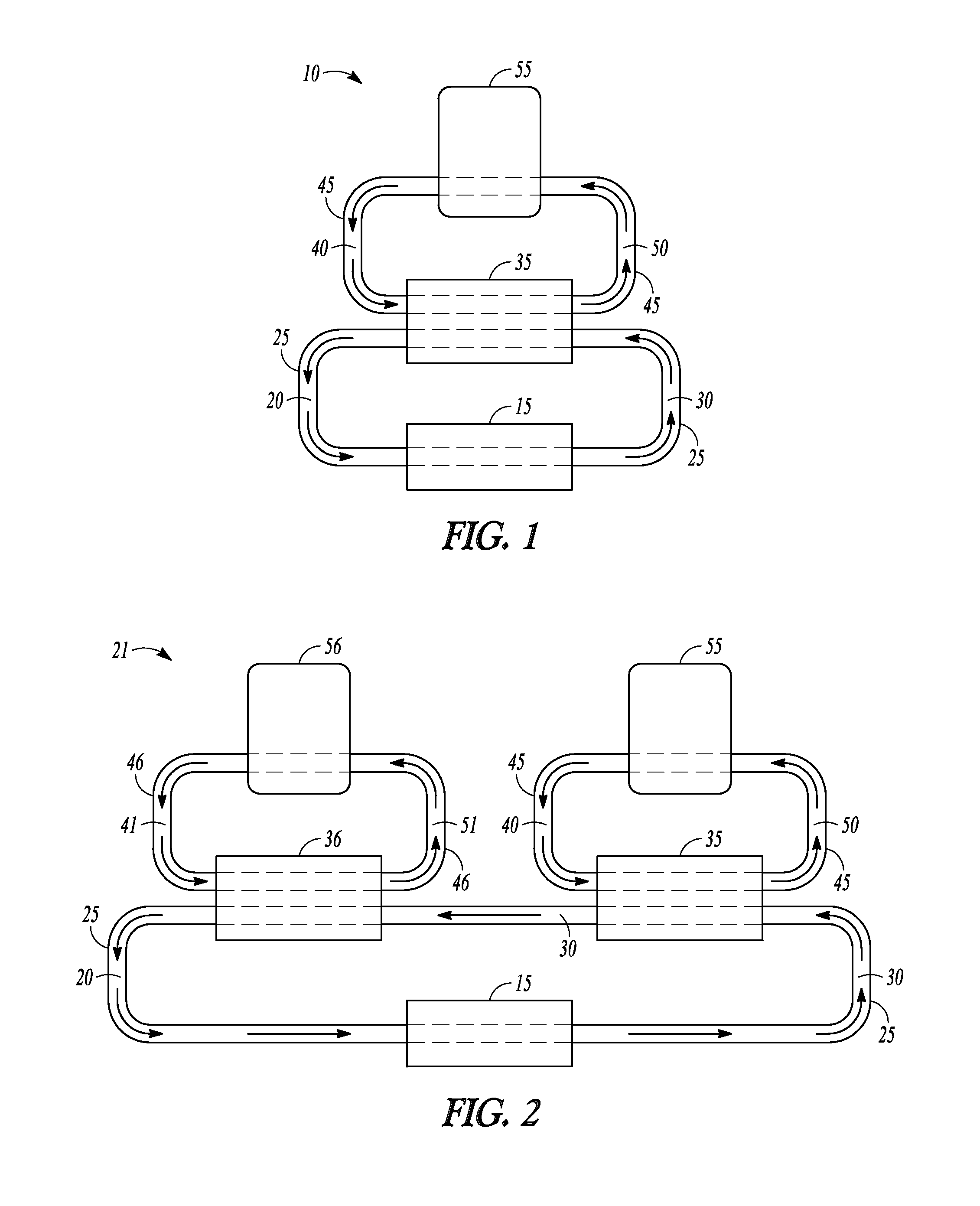Multiple heat-transfer media
a heat-transfer media and multi-layer technology, applied in indirect heat exchangers, chemical/physical/physicochemical processes, lighting and heating apparatuses, etc., can solve problems such as safety risks, inconvenience, efficiency loss, etc., to reduce the risk of explosion, reduce the risk of coked tubes in heaters, and reduce the risk of fir
- Summary
- Abstract
- Description
- Claims
- Application Information
AI Technical Summary
Benefits of technology
Problems solved by technology
Method used
Image
Examples
example 1a
Comparative Example. Liquid Phase Heat-Transfer Medium in Primary Heating Loop
[0079]Therminol® 66 is heated to about 340° C. and circulated through a primary heating loop in a nylon-6,6 manufacturing plant. The primary heating loop circulates the Therminol® 66 at a suitable flow rate between a powerhouse and heat exchangers on an evaporator, reactor, and finisher before transferring the Therminol® 66 back to the powerhouse for reheating. Approximately 10,000,000 L of Therminol® 66 is used in the primary heating loop. The Therminol® 66 remains a liquid throughout the process.
[0080]In the continuous nylon-6,6 manufacturing process, adipic acid and hexamethylenediamine are combined in an approximately equimolar ratio in water to form an aqueous mixture containing nylon-6,6 salt, having about 50 wt % water. The aqueous salt is transferred to an evaporator at approximately 105 L / min. Heat is transferred to the evaporator from the Therminol® 66 in the primary heating loop, allowing the ev...
example 1b
Comparative Example. Gas Phase Heat-Transfer Medium in Primary Heating Loop
[0082]Dowtherm™ A is heated to a vapor at about 340° C. and about 400 KPa pressure and circulated through a primary heating loop between a powerhouse and various unit operations in a nylon-6,6 manufacturing plant, where it transfers heat to the various unit operations before being transferred back to the powerhouse for reheating. Approximately 10,000,000 L of Dowtherm™ A is used in the primary heating loop. The Dowtherm™ A remains a vapor throughout the process, and is circulated at a sufficient rate that the material does not drop below the saturation temperature in the cycle.
[0083]The continuous nylon-6,6 manufacturing process is performed as described in Example 1a, but using the vaporous Dowtherm™ A throughout the process. As compared to other methods using a heat-transfer material that undergoes a phase change during the heat transfer, the total change in temperature of the Dowtherm™ A per KJ of heat tra...
example 1c
Comparative Example. Volatile Heat-Transfer Medium in Primary Heating Loop with Condensation
[0084]Example 1b was followed, but using Dowtherm™ A with a rate of circulation such that sufficient heat is absorbed from the Dowtherm™ A during heat transfer to the various unit operations to cause partial condensation of the Dowtherm™ A in the primary heating loop. To circulate the generated liquid to the remaining unit operations and back to the powerhouse, additional equipment is required, including a liquid knockout drum, additional piping, and pumps to return the condensate to the powerhouse for reheating and revaporization. Maintaining a precise temperature of each unit operation is difficult, since the temperature of the heat-transfer medium can only be adjusted overall and cannot be adjusted for an individual unit.
PUM
| Property | Measurement | Unit |
|---|---|---|
| saturation temperature | aaaaa | aaaaa |
| temperature | aaaaa | aaaaa |
| temperature | aaaaa | aaaaa |
Abstract
Description
Claims
Application Information
 Login to View More
Login to View More - R&D
- Intellectual Property
- Life Sciences
- Materials
- Tech Scout
- Unparalleled Data Quality
- Higher Quality Content
- 60% Fewer Hallucinations
Browse by: Latest US Patents, China's latest patents, Technical Efficacy Thesaurus, Application Domain, Technology Topic, Popular Technical Reports.
© 2025 PatSnap. All rights reserved.Legal|Privacy policy|Modern Slavery Act Transparency Statement|Sitemap|About US| Contact US: help@patsnap.com


